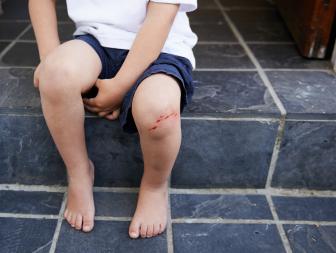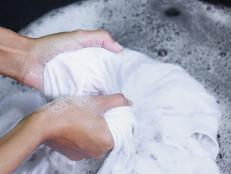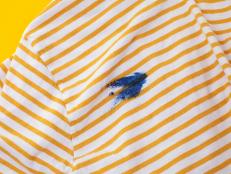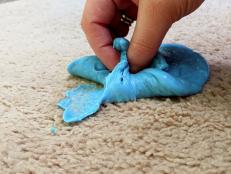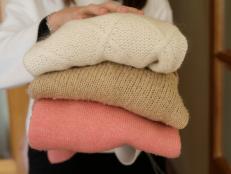How to Get Oil Out of Clothes
Learn how to remove oil stains from your clothing — just remember, the best thing to do is act quickly!

Shutterstock/Maliflower73
Removing oil stains from your clothing takes a little work, but it isn't hard.

Splatters and splashes of oil take their toll on our garments in the kitchen, the garage and the workshop. Your prior experiences with trying to clean cooking oils or lubricants might lead you to think that your clothing is ruined. But, that's quite the opposite!
Learn how to get oil stains out of clothes when accidents happen and improve the chances that you can completely remove the stain.
Understanding Oil Stains
Oil stains are challenging to clean from fabrics due to their ability to penetrate deeply and adhere strongly. Furthermore, cooking oils can vary in chemical composition due to the proportions of fatty acids, and motor oils based on the viscosity and additives. Whether you've been splattered by olive oil while cooking or got gear oil on your pants while lubricating your bike gears, you can get help from specific treatments and solvents that prevent a long-term stain.
TOP TIP: Taking quick action is important to successfully remove a fresh stain. It can help stop stains from spreading through fabric fibers. When oil stains are set, they penetrate deeper into the material, making them more difficult to remove. The longer the oil sits, the more it adheres. Plus, it oxidizes over time, becoming darker and increasingly stubborn to eliminate.
How to Get Rid of Fresh Oil Stains
Taking quick action makes it easier to successfully remove a fresh oil stain. Follow these steps.

Blot fresh oil stains with a clean cloth.
- Blot the stain with an absorbent cloth or paper towel. Don't rub it, just blot!
- Absorb the stain using a material like cornstarch, baking soda or talcum powder. Distribute the powder. Sprinkle the powder across the stain so it falls between the fibers of the garment. Let it sit for 15-30 minutes.
- Let the powder absorb the oil. The powder will clump as it absorbs the oil. Turn the garment over and gently brush the loose powder away.
- Pretreat the stain using a stain remover or liquid laundry detergent. Let it sit for another 5-10 minutes to penetrate the fabric.
- Launder the garment in hot water with your regular detergent.
- Allow the garment to air dry. Once it's dry, you'll be able to see if the stain is still there or if it needs additional treatment. Avoid putting the garment into the dryer until you're completely sure it is gone. While the heat from the water is OK, the heat from the dryer will set in the stain.

Talcum powder helps to absorb oil stains on clothing. (At least the hot oil didn't burn my wrists!)
How to Remove Old Oil Stains From Clothes
- Pretreat the stain. Penetrate the stain and the fabric with stain remover or liquid laundry detergent. Let it sit for 5-10 minutes.
- Agitate the cleaner on the stain using a toothbrush or massage it in with your fingers if the fabric is delicate. Allow it to sit for another 5-10 minutes.
- Launder the garment in the hottest water temperature recommended for the fabric.
- After its wash cycle, allow the garment to air dry. It's important to check the condition of the stain before applying heat from the dryer. Dryer heat can set the stain further.
How to Remove Set-In Oil Stains
For tough stains that have already been through the washer and dryer, you'll want to reactivate the stain. This seems counterintuitive, but it makes it easier to clean a stubborn stain. If you're using this method, you must handwash and avoid the washing machine!

Start removing tough, set-in stains by spraying them with a lubricant
- Spray the stain with lubricant like WD-40 or Gear Hugger. Let the solution soak into the fabric for 20-30 minutes.
- Apply a stain remover or a small amount of liquid laundry detergent to pretreat the stain. Let it sit for 5-10 minutes.
- Hand wash the garment in clean water. Avoid putting it into the washing machine or dryer as the sprays can be flammable.
- Inspect the garment. Retreat with laundry detergent and water again if necessary.
- Rinse and air dry.
Special Considerations for Different Fabrics
While denim and cotton or synthetic garments are easy to pretreat and launder, not all fabric is so easy. "When it comes to oil on silk, linen and wool, it is important to treat each clothing item differently as each fabric has its own special attributes and level of delicacy,” shares Sara Chris Briones, textile manager at Prism Specialties.
How to Hand-Wash Clothes
Make clothes last longer and target tough stains by hand-washing items such as bras, lingerie, tights, sweaters, baby clothes and more.
Sara recommends talcum powder for the most delicate garments, as it can easily be sprinkled in between the fibers of your garment, safely absorbing oil.
Hand Washing Tips for Wool, Silk and Linen
- Right when oil has spilled on the fabric, get two small towels. Put one towel underneath the material.
- Lightly dab the fabric with the other towel to begin absorbing the oil.
- Next, put a small amount of talcum powder on the stain. Let the powder sit on the stain for a few minutes. Use a soft toothbrush to distribute it into the fibers, if necessary.
- Stir 1/3 of a teaspoon of liquid dish soap into a cup of water. Add that solution to the stain and lightly dab the area. Let the fabric sit for about 5-10 minutes.
- Hand wash the garment until it is clean and hang dry
More Advice on Washing Clothes
How to Wash Jeans
Learn how to wash denim to protect its color and fibers.
Get Blood Out of Clothes
Removing blood stains from clothes isn’t as tough as you think.
Get Gum Out of Clothes
Get step-by-step instructions for how to get gum out of clothes

.-Battle-on-the-Beach-courtesy-of-HGTV.-.jpg.rend.hgtvcom.196.196.suffix/1714761529029.jpeg)






